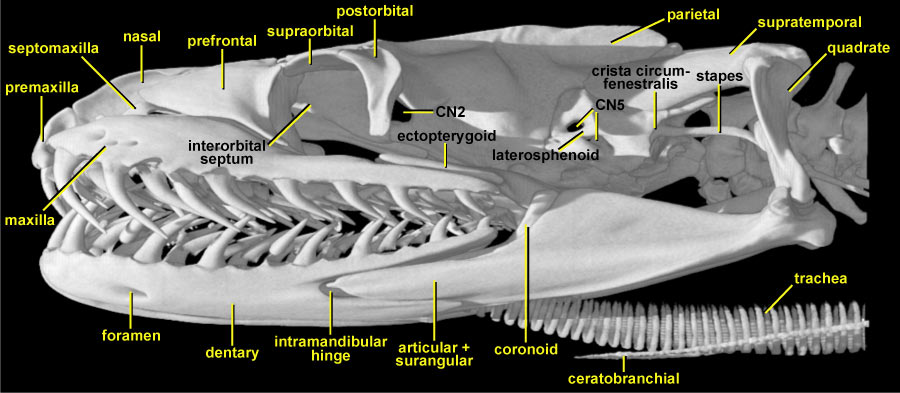I evidently made a mistake by not applying to do research in Australia. They've aparently found another large, non-macrostomatan (what you typically think of when you think snake) snake. From the picture below a couple of really cool things pop out at me right away. First, the quadrate looks rather similar to the c-shaped condition of mosasaurs. The other thing is that the trigeminal foramen in the prootic of the braincase is open anteriorly and would have been bound on that side by the descending flange of the parietal. I'll grant that this second feature could just be an artifact of breakage, but if not, then it represents the primitive condition also seen in Wonambi. Another cool thing is the jugal. In varanids, the lower half of the orbital margin is made up of a robust jugal. It appears to be the same case here. In a python, there is no jugal. In the defense of people who say that mosasaurs are not the sister taxon to snakes however, this snake has big nasals and small premaxillae (the other way around in varanoids), the frontal-parietal suture is pointed backwards rather than being straight and I see no supratemporal listed in the diagram.
Yurlunggur:

Python

-Immunologists realize that lab mice have two thymuses (thymice?), not one.
I honestly can't blame them too much for missing this little organ for the last two hundred or so years. It's about the size of the head of a pin and looks like a lymph gland. My only concern is that this might be an abaration of using lab mice rather than wild mice. Lab mice are all genetically identical. It's like there are 80 million clones. If however a mutation were to rise in one of the breeding stocks of lab mice (say, for an extra thymus), it wouldn't really get noticed and it might be coinsidence that this particular research team got mice from this mutated stock. In humans, the number of thymuses is incosistant, with most people having one in the chest and some having an additional one in the neck as with these mice. I'd like to see if a wild mouse has an extra thymus.
-Leave it to scientists to find a way to grow tits in the lab.
Naturally, the report only talked about the prospects of this research for treatment of breast cancer and not augmentation.
-Plants produce greenhouse gas
I was forced in high school to memorize the Kreb cycle, the Calvin cycle and several other cycles and pathways that I've since forgotten the name of. But aparently there is a new one that produces methane under normal atmospheric conditions. I can't wait for the conservatives to jump all over this and say that cutting down the rainforest will help eliminate this greenhouse gas.
-Further evidence that my Y-chomosome is mostly junk DNA
Any guy who has taken genetics or who has a girlfriend that has, has been told that only a very small part of the gender determining Y-chomosome actually does anything; specifically regulate the production of androgens and of hair on the earlobes. The rest of the chromosome is there so that it can line up with the X during myocis. To do this, there has to be some similarity to the X, otherwise the two wouldn't come together. Aparently though, this hasn't stopped repeated, massive mutations in the Y-chromosome that further show that you can do a whole lot to it (except have more than one) without deleterious effects.
-Hummingbirds capable of watching scientists
A study conducted on rufus troated hummingbirds provides evidence that the birds are able to remember now only what something looks like and where it is, but when they last saw it. This was done by refilling artificial flowers with nectar at specific intervals. The hummingbirds made a pattern of visiting the flowers right after they were filled. So either they can remember things well, or can deduce that everytime a person goes to a fake flower, it gets refilled.
I (and a few other Albertan Paleontologists) owe Nick Longrich an apology.
Nick didn't make the cover of Scince magazine, nor did he contribute to the article that it relates to. He did however give a talk on the exact same kind of convergence on the semi-aquatic lifestyle in a mesozoic non-eutherian mammal last September at a conference at the Royal Tyrrell Museum. Nick is known among his friends (and we really do consider ourselves friends of his) for being able to talk your ear off for extended periods of time and for drawing dramatic conclusions from only a little evidence. In September he tried to convinse us that didelphadon was semi-aquatic and had a beaver-style, flattened tail. I and a few others were skepticle because he only had two, relatively unrelated pieces of evidence. First was his recognition of some flattened mammalian tail vertebrae, the second was a well known set of robust jaws. The two have never been found together. But this new chinese discovery makes it look like Nick might have been right after all.
2 comments:
I would have to say that someone finding a brilliantly preserved specimen on the far side of the planet does nothing to support Mr. Longrich's identification of a couple of caudal vertebrae and the subsequent conclusions. He's lacking in the whole 'evidence' department, whereas his Chinese colleagues have everything except the skull.
First of all, I don't have access to the article now that my university account has expired, so I'm not fit to judge how similar the chinese specimen is to the isolated verts examined by Mr. Longrich (though I'm pretty sure Nick must be planning a few trips to examine the specimen himself). The point I tried to make was that Nick could be right, not that he necessarily is.
p.s. thank you for having a constructive comment.
Post a Comment